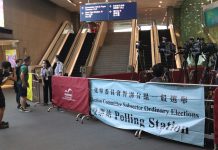Lee Tung Street and Tai Yuen Street in Wan Chai face different fates under urban development
By Kayi Tsang & Shell Zhang














Wan Chai, one of the business districts in Hong Kong, is densely packed with skyscrapers and landmarks. Walking underneath buildings of modern architecture in Lee Tung Street, few people still remember the past glories of Hong Kong’s printing industry and the street where it was nurtured.
During the 1950s, Lee Tung Street was a street famous for printing and manufacturing of wedding cards. It is why the street was also known as “Wedding Card Street”. Printing shops lined up along the sideways in tenement houses or “tong laus” in Cantonese (唐樓). Back in those days, visiting Lee Tung Street for invitation cards of a wedding banquet was a must for the bride and groom-to-be.
In 2005, the Urban Renewal Authority resumed all the property rights of Lee Tung Street and initiated a revitalisation project. Its old buildings were demolished in 2007 and replaced by newly designed architecture. High-class boutiques, specialty shops, restaurants, cafés and hotels moved in and became the new occupants.
Lee Tung Street, renamed as Lee Tung Avenue after its remake, has become a popular tourist spot, for Instagrammers in particular. People from all over the world love to visit the place especially during festivals when seasonal decorations fill the pathway with festive spirits.
The outlook of the street seems to have improved. However, former tenants who were forced to leave and gave up their businesses, could not return to where they belonged. The shop rents in Lee Tung Avenue have soared after the renewal. Most of the shops are luxury chain stores selling cookware, accessories and cosmetics, or restaurants offering Japanese and French gourmets without any relations to the wedding card business.
Target customers of the street have shifted from local grass-roots to upper class and foreign tourists. The traditional culture, as well as the interpersonal relationships among residents, can no longer be found.
Adjacent to Lee Tung Avenue is another street with strong nostalgic local style – Tai Yuen Street. Even the locals may not be able to tell you where Tai Yuen Street is, because they may only know its nickname – “Toys Street”. A diversity of classic toys is sold in the myriad of toys stores there. It is a paradise for toy collectors and young children, and it also has a wide variety of stores selling daily necessities to residents in the neighbourhood.
While grown-ups can recollect their fondest childhood memory at a low price easily, the future of Tai Yuen Street is uncertain. Like Lee Tung Street, Tai Yuen Street is part of the Wan Chai old district development project.
In 2007, Tai Yuen Street underwent redevelopment. Eighty-six stores in southern Tai Yuen Street were relocated to ease the traffic problem in the district. The original plan of the government was to demolish the whole street, but it aroused strong objections from the public. The upper part of the street has been preserved. Lai-deng, 80, who has lived in Wan Chai for more than 70 years, says Tai Yuen Street was known for selling old clothes in bygone days. It only became “Toys Street” about 20 years ago. “It all began with the street markets, then the trolleys. The stalls only started to appear 10 years ago,” he says.
As a witness to the changes of Tai Yuen Street, he says he misses Shuang Xi Lou, a Chinese restaurant in the street the most. Renowned for its traditional and nostalgic characters, Shuang Xi Lou now lives only in the memories of those who dined there in its prime.
Leung, a grocery owner who has been selling umbrellas in a street stall since 1962, says more people visit the street after its redevelopment in 2007. Electricity was provided and lightings were installed. Individual stalls were reorganised. “It has become more convenient for shoppers, and for us as shop keepers,” she says. Leung adds that the variety of goods sold in the street has been multiplied after the renovation, attracting customers looking for different commodities.
“Tai Yuen Street is a unique place and it is worth preserving,” says one of the owners who has been running her street stall business in Tai Yuen Street for more than 10 years. Although she never makes huge profits from her business, she is unwilling to relocate her store or to quit the business, no matter how much compensation the government is offering them.
Under rapid economic development, old streets seem to have lost their original appearance and identities. Yet, the history they hold, the cultural values they carry and the community stories they record, are priceless treasures of the city. The destiny of the two streets and the story of our time are still in our hands.
Edited by Edith Chung & Valerie Wan








































